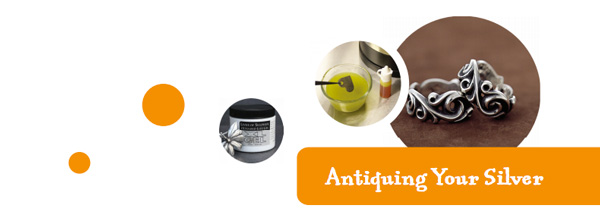
Antique silver without waiting a hundred years!
So you've learnt the basics in metal clay jewellery, and now you want to try something new? Have you ever wondered how they get that nice antique, darkened effect on silver?
The answer is Liver of Sulphur (LOS).
LOS is used to give your silver an antique look, a patina, which can be black on a range of colours. The silver reacts chemically to the sulphur, which makes it go darker and darker, it oxidises, until it finally goes black. This is the same process as when silver tarnishes, we're just speeding it up.
LOS is excellent to use on a textured surface, as it emphasises the difference between the raised and lower parts of the texture. It's very satisfying process; dipping and rinsing your pieces, seeing the colours appear. Once you start experimenting you might actually discover that a lot of designs are enhances by the patina. The contrast of the dark oxidised silver against bright gold accents or brass is stunning. It can be used on copper, fine silver, and sterling silver, and is ideal for metal clay.
LOS deteriorates when in contact with air and light. Store it in the dark, and keep the top on. Even when you do this, it will have a limited shelf-life. The solution gets weaker with age - it gets slower and less effective. Using hotter water and a longer soak time can extend the life a little.
LOS has strong smell. The sulphur in it smells like rotten eggs. As with all chemicals, be sensible and don't breathe it in. Use in a ventilated area; especially is you are pregnant or asthmatic.
In the UK, LOS is Potassium Polysulphide: a slightly corrosive product. It's mostly sold in rough chunks, from which you break off pea-sized bits. However, LOS bought from most Art Clay distributors is a mild liquid solution, which is harmless is you get it on your skin. In Japan it is actually used in the bath, supposedly healing all sorts of ailments. The instructions in the article are written for this product. Wherever you buy LOS, make sure you read the data sheet carefully and follow the safety precautions.
Your silver should be finished (brushed, burnisher or polisher), and clean before applying the LOS. Mix a teaspoon of bicarbonate of soda with a few drops of water into a paste and clean your piece with this. Rinse carefully with warm water. Wear rubber gloves, or you might end up with a lingering smell of rotton eggs on your hands for the rest of the day. You can also use a stainless steel, plastic, or wooden tweezers (chopsticks are perfect, if you know how to use them!). Mix the solution in a stainless steel, ceramic, or glass bowl, which you can then set aside for LOS in the future.
For a black patina:
For a faster result, heat your silver (with hot water or a hair dryer) before dipping it. Mix about 10 drops of LOS in about half a mug of hot (not boiling) water. Drop your silver into the mix and swirl it around. If your LOS is fresh, your piece should go black in a matter of seconds. If your mix is old, or has weakened, it will take longer. You might also need to add a little more LOS to the mixture. Rinse well with water. Remember that the darker it gets, the harder it is to polish off.
For a range of colours:
You can also get a beautiful range of colours: gold, copper, purple, blue, blue-grey, and then black. Use the same amount of LOS, but mix it with cooler water, and don't heat your silver. This will slow down the process and will allow you to stop it at the colour you like. Dip and remove it quickly, rinse in cold water, and repeat until you get to the colour you are after. Experiment with the temperature, amount of LOS, or maybe by adding a drop of ammonia or some salt, which can give you more vibrant colours.
Applying with a brush:
You can also apply the mix with a brush. Try painting just parts of the piece for interesting effects. Try layering the LOS, by applying it several time. For a random effect, or varying colours, let it splash or drip from the brush.
After dipping:
After applying the LOS, polish your piece with a soft cloth and metal polish, to remove the patina on the raised parts and bring out the silver highlights. Don't use metal polish if you want to keep a range of colours.
I don't like it!
If you're not happy with the effect, you can remove the patina by heating your piece with a torch, gas stove, or kiln, until it goes white. Then you can start all over again if you want to.
Masking effects:
You can also mask parts of the silver before applying the LOS. This works best on a highly burnished piece, as this is less porous. People use a range of different resists: wax, watercolour masking fluid, or even nail varnish (which is removed with acetone).
LOS will wear off with time, and will also chance colour slightly. You can't avoid this, but there are some ways to help protect the patina. Some people coat it with a clear spray varnish, or a mixture or equal parts naphtha (Besolene or Zippo lighter fluid) and beeswax. Mix into a cream, apply a thin layer, let dry and then buff wide a dry cloth. Varnish can chip off, and can also go yellow with time, but can be reapplied. Any coating you put on will also change the colour of the oxidisation slightly, so try it out on some test pieces first.
Some extra hints and tips:
Brush, burnish, polish and clean your silver well before dipping for best results.
Heating your piece before dipping will speed up and intensify the reaction.
Desperate to try but don't have any LOS? Put a hardboiled egg, peeled and cut in half, in a plastic container or bag, together with your silver (don't let them touch). Takes a lot longer but works!
We sell two different types of LOS, or XL Gel. This is LOS in a gel form. It is great for painting on your jewellery, as it can be used straight from the pot, it also has an extended life. The manufacturers left it in their office with the lid off... and it still works!
Happy Antiquing!


